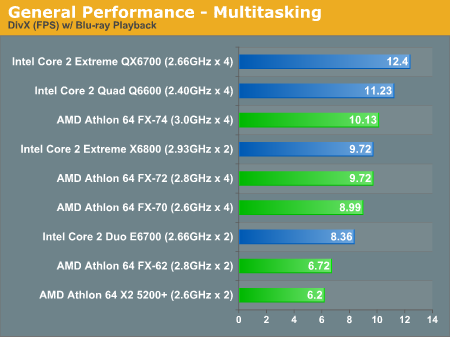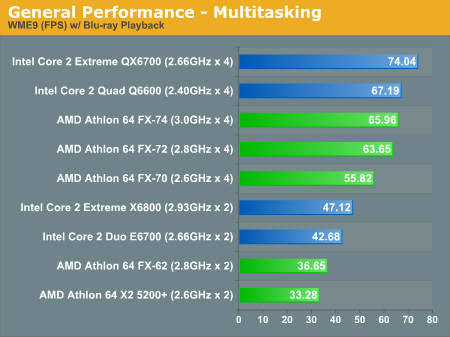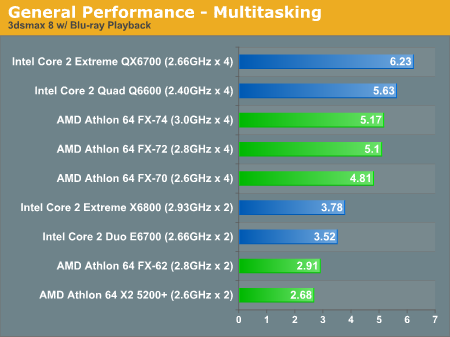AMD's Quad FX: Technically Quad Core
by Anand Lal Shimpi on November 30, 2006 1:16 PM EST- Posted in
- CPUs
Multitasking Performance
When we were trying to think up new multitasking benchmarks to truly stress Kentsfield and Quad FX platforms we kept running into these interesting but fairly out-there scenarios that did a great job of stressing our test beds, but a terrible job and making a case for how you could use quad-core today.
Without a doubt, in the next two years the number of applications that see a benefit when running on four cores will increase dramatically. Even multitasking under Windows Vista will make the argument for more cores easier (simply opening a new Explorer window in Vista will eat up 10% of the CPU time of a Quad FX system), but our Vista benchmarks are not yet complete and we wanted to have something to showcase for this review.
While working on our Quad FX article we also happened to be working on a follow-up to our HDCP Graphics Card Roundup, focusing on H.264 decoding performance in Blu-ray titles. A light bulb went off and we had our benchmark: how many cores do you need to watch a high bit-rate Blu-ray movie and do something else at the same time on your PC?
The movie we used was Xmen III, encoded in H.264, and featuring bitrates in excess of 40Mbps at times. Our benchmark starts at the beginning of Chapter 18 and continues until our background tasks are complete. This particular segment ranges in bitrate from 13Mbps up to above 40Mbps, with the average falling in the 18 - 24Mbps range.
We played the movie in the foreground, while in the background we either ran our Cinebench test, encoded a DivX movie, encoded a WME9 movie or performed our 3dsmax test.
The two rendering tests are important because rendering can take a bit of time and it might be nice to entertain yourself with a movie while your rendering completes; after all, what's the point of having $1000 worth of CPUs if you can't use them for entertainment?
The two encoding tests are also important because being able to encode and decode at the same time is a fundamental requirement for a DVR, and at some point the next-generation of media center PCs will need to be able to decode high bitrate HD movies while encoding others. We chose to include both DivX and WME because DivX runs much better on Intel CPUs, while the standings are a bit closer under WME, to give you a better overall impression of how the two platforms handle these heavy multitasking scenarios.
Our first test involved us playing back the BD title while running our multi-threaded Cinebench test; we reported the Cinebench score upon its completion:

The dual core processors all fall to the bottom of the list and basically perform like single-core CPUs while decoding the Blu-ray movie. The quad-core setups do much better and perform very well, but all of the CPUs in this test were able to run without dropping any frames in the BD movie.
Making things a bit more difficult, our next test had the same movie playing back but this time we ran our DivX encoding test in the background. We reported the DivX encoding frame rate upon completion:

Performance is pretty much what you'd expect, although Intel's superior DivX encoding performance results in the Core 2 Extreme X6800 doing almost as well as the FX-74. What you don't see however is how well these systems played back the Blu-ray movie; none of the dual core setups were able to play the BD movie smoothly, not even the Core 2 Extreme X6800. The movie was basically unwatchable due to all of the pausing and stuttering.
All of the four core systems played the BD movie fairly well; although they all dropped some frames, it wasn't enough to totally ruin the experience.
Next up we tried playing our BD title while running our WME9 test, and found similar results:

Once again, none of the dual core platforms were able to play the BD title even remotely smoothly. The quad-core setups were able to play the movie while encoding, but still managed to drop some frames (not enough to ruin the experience though).
Our final multitasking test has us playing the same BD title while running our 3dsmax 8 render test:

Much to our disappointment, none of the systems could handle this workload without ruining the movie playback; even the quad-core setups had troubles. We're not talking a few dropped frames, but rather the movie playback would be completely stopped at times. It looks like we may have a scenario for either more GPU assisted H.264 decode or an 8-core Quad FX platform in the future.










88 Comments
View All Comments
BikeDude - Tuesday, December 5, 2006 - link
Could the reason be that 1GB per memory node is simply too little?On a configuration like this, you'll easily see one of the nodes with only 256MB or so left...
So, put in some more memory! At this point 32-bit XP will be limiting, even for 32-bit apps. (XP won't address more than 2^32 Bytes, some of this will be masked by PCI and PCIe devices, and additionally each process only has a 2GB address space for code&data unless you upgrade to 64-bit Windows) Also be aware that nVidia ForceWare 80.00 and newer lost PAE support. You'll experience crashes and non-working games if combined with a PAE aware 32-bit OS (such as Win2003). ForceWare 79.11 works fine though.
(BTW: MSFT added NUMA support in XP SP2)
Kiijibari - Saturday, December 2, 2006 - link
Hi Ananand,sounds credible, because there is some extra cache snooping traffic going on, anyways, please keep us posted if there is a new BIOS version available, and if it would "do" something :)
Windows schweduler differences between XP and VISTA would be interesting, too.
So far there were only Win32 XP vs. Win Vista64 comparisions, not possible to draw a fair conclusion with that data.
Thanks a lot
Kiijibari
mino - Friday, December 1, 2006 - link
One important question:Are those new FX-7x CPU identical or is there some differentiation employed ???
Kiijibari - Saturday, December 2, 2006 - link
identical to what ?If you meant Socket-F Opterons, then yes, they are identical, if the BIOS allows it, then normal Opterons should be able to run in 4x4 boards, too.
cheers
Kiijibari
mino - Sunday, December 3, 2006 - link
Thanks that info(if correct) pretty much clears the FUD.Griswold - Saturday, December 2, 2006 - link
How so? The 2P+ Opteron IMC wants buffered RAM, while these FX types do not. I dont think a simple BIOS hack can circumvent that.Kiijibari - Saturday, December 2, 2006 - link
*gasp*Du you really think AMD engineers, tests, validate, etc. a CPU for a niche market ??
There are maybe only a few thousand 4x4 CPUs, that are sold worldwide per month ... it would be economical ridiculous.
But if you dont know anything about business, maybe that will convince you:
http://www.aceshardware.com/forums/read_post.jsp?i...">http://www.aceshardware.com/forums/read_post.jsp?i...
cheers
Kiijibari
lollichop - Sunday, February 26, 2017 - link
All idiots talking about old CPUs here :D Fast forward 11 years, Ryzen will be out in a week's time.